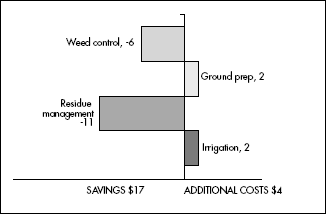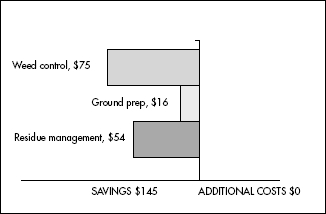|
Spring/Summer 2005 - Vol. 5/No. 3
Economic performance ofsustainable farming practices
By Karen Klonsky and Pete Livingston
| |
 |
|
SAFS research assistant Aaron Ristow checks datalogger monitoring surface runoff in vetch cover crop plot. (Photo by: Sam Prentice) |
| |
One of the major goals of the Sustainable Agriculture Farming initiatives at
UC Davis is to provide information about the feasibility of adopting
conservation tillage and cover cropping at the farm level. The project
includes two tillage schemes: standard tillage (ST) and conservation
tillage (CT), and three farming methods: conventional, organic, and winter
legume cover crop. All three production methods are used in combination with
both tillage systems for a total of six alternative systems. Each of the
six systems is used in the trials to grow both processing tomatoes and field
corn. This article will examine the profitability of the alternative farming
systems under investigation at SAFS based on the 2004 cropping season
results.
We calculated the costs and returns for each of the alternative farming
systems and each of the crops based on the calendar of operations used in
the trials and the yield results. The costs per acre are based on the
equipment used and the time it would take in a farm setting rather than a
field trial. We used the input rates for the trials along with input costs
provided from local suppliers. The prices received are those typical for
the area in 2004. We calculated the organic system revenue both with and
without organic premium prices realized by local growers. The profitability
of each system equals the revenue minus the costs. A positive return
indicates that the system is economically sustainable at least in the short
run.
Tomato. The 2004 tomato yields were disappointing for all
systems, falling below the Yolo County average. In all cases the standard
tillage systems were higher-yielding than the conservation tillage systems
(Table 1). At a price of $50.10 per ton the standard tillage systems
garnered $179 more per acre for the conventional system, $46 more for the
winter legume cover crop system, and $372 per acre more for the organic
system at conventional prices and $475 more at the higher organic premium
price of $65 per ton (Table 1).
These higher profits equal the break-even cost savings required to make the
profit from the conservation tillage systems equal to that of the standard
tillage systems. For example, if conservation tillage results in a savings
of more than $179 per acre for the conventional system then it is more
profitable to use CT because the reduction in costs is higher than the loss
in revenue. On the other hand, if the cost saving from CT is less than $179
then it is more profitable to use standard tillage because the loss in
revenue reduced profit more than the cost savings increases profit.
For the conventional system the cost savings from conservation tillage was
only $13 for the conventional system and $20 per acre for the cover crop
system, well below the break-even thresholds (Figure 1). The savings came
from reduced weed control costs and reduced residue management costs
(Figure 1). The ground prep costs were actually higher for CT than ST
because of the extra operations used to manage the beds due to the high
amount of residue left from the preceding corn crop. For the organic
system the production costs were actually higher for CT than ST due to
higher hand weeding costs.
 |
|
 |
| Figure 1. Comparison of Conventional Tomato Costs with Conversion to Conservation Tillage 2004 |
Figure 2. Comparison of Conventional Corn Costs with Conversion to Conservation Tillage 2004 |
| |
|
Corn. The yields for the conventional systems for corn were above the
Yolo County average in 2004, but the organic and winter legume cover crop
systems fell far below the county average for both the conservation
tillage and standard tillage methods (Table 1). The constraints of cover
crop management in the winter legume and organic systems delayed planting
these systems, which most likely impacted potential yield. In all cases
the standard tillage systems yielded about 400 pounds per acre more than
the analogous conservation tillage system for a difference of $18 per acre
(Table 1). At a price of $88.52 per ton, the difference is $18 per acre.
For the organic system at the premium price of $140 per ton, the CT system
showed higher revenue of $26 (Table 1). It is important to keep in mind
that, in general, processing tomatoes are a much higher grossing crop than
field corn. Therefore, profit maximizing decisions are based primarily on
the performance of the tomato crop and not the corn crop.
The savings from conservation tillage was much higher for corn than tomato.
The savings were due to a decrease in ground preparation, weed control,
and residue management. The savings were $145 per acre for the conventional
system, $73 per acre for the organic system, and $61 per acre for the winter
legume cover crop system (Figure 2). However, the conventional system was
the only one to show a positive return above operating costs. In this case
the cost savings from conservation tillage of $145 per acre was higher than
the revenue reduction of $18 per acre for a net increase in profit of $127
per acre (Table 1). Both the organic system and the winter legume cover crop
system showed a loss with conservation tillage and standard tillage, although
the loss was greater under standard tillage.
| Table 1. Costs and Returns 2004 |
| TOMATOES |
Standard Tillage |
Conservation Tillage |
CT minus ST |
| Conv |
Org |
Org+ |
WLCC |
Conv |
Org |
Org+ |
WLCC |
Conv |
Org |
Org+ |
WLCC |
| Yield (tons/A) |
29.5 |
31.3 |
31.3 |
27.3 |
26 |
24 |
24 |
26.4 |
-3.5 |
-7.3 |
-7.3 |
-0.9 |
| Price/ton ($) |
51 |
51 |
65 |
51 |
51 |
51 |
65 |
51 |
0 |
0 |
0 |
0 |
| Gross returns ($/A) |
1,505 |
1,596 |
2,035 |
1,392 |
1,326 |
1,224 |
1,560 |
1,346 |
-179 |
-372 |
-475 |
-46 |
| Operating cost ($/A) |
968 |
1,177 |
1,177 |
1,042 |
955 |
1,350 |
1,350 |
1,022 |
-13 |
173 |
173 |
-20 |
Net returns above
operating costs ($/A) |
537 |
419 |
858 |
350 |
371 |
-126 |
210 |
324 |
-166 |
-545 |
-648 |
-26 |
|
| CORN |
Standard Tillage |
Conservation Tillage |
CT minus ST |
| Conv |
Org |
Org+ |
WLCC |
Conv |
Org |
Org+ |
WLCC |
Conv |
Org |
Org+ |
WLCC |
Yield (tons/A) |
6 |
2.4 |
2.4 |
2.1 |
5.8 |
2.2 |
2.2 |
1.8 |
-0.2 |
-0.2 |
-0.2 |
-0.3 |
Price/ton ($) |
90 |
90 |
140 |
90 |
90 |
90 |
140 |
90 |
0 |
0 |
0 |
0 |
Gross returns ($/A) |
540 |
216 |
336 |
189 |
522 |
198 |
308 |
162 |
-18 |
-18 |
-28 |
-27 |
Operating cost ($/A) |
429 |
523 |
523 |
406 |
284 |
450 |
450 |
345 |
-145 |
-73 |
-73 |
-61 |
Net returns above
operating costs ($/A) |
111 |
-307 |
-187 |
-217 |
238 |
-252 |
-142 |
-183 |
127 |
55 |
45 |
34 |
Conclusion
The analysis clearly demonstrates the potential for CT to decrease operating
costs for both processing tomato and corn. The cost savings in 2004 were
greater for corn than tomato because of the extra operations used to shape
the tomato beds before transplanting. Also, the organic tomato system using
conservation tillage required additional hand weeding. Despite these
encouraging findings, CT will not be attractive to growers unless yields are
comparable to those under standard tillage. Therefore, the challenge for the
coming season will be, first and foremost, to modify the systems to improve
yields without compromising the spirit of conservation tillage. We are
exploring modifications to optimize yield and/or economics in the winter
legume and organic systems. These include evaluating varieties to overcome
planting date issues, optimizing CT to reduce field passes and soil
disturbance, and determining innovative weed management practices.
• Table of Contents •
|
|